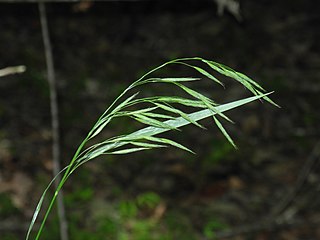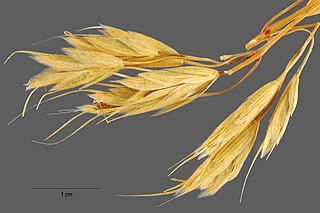
Bromus arvensis, the field brome, is a brome grass native to Europe and Asia. The specific epithet arvensis is Latin, meaning "of cultivated land".

Bromus hordeaceus, the soft brome, is an annual or biennial species of grass in the true grass family (Poaceae). It is also known in North America as bull grass, soft cheat, and soft chess.

Bromus secalinus is a species of bromegrass known as rye brome. The specific epithet secalinus is Latin, meaning "rye-like". The fruits are hard, rounded glumes that appear superficially similar to the rye grain, which gives the brome its common and scientific name. The grass has a diploid number of 28.

Festuca occidentalis is a species of grass known as western fescue. It is native to much of the northern half of North America and is most widely distributed in the west. It is most often found in forest and woodland habitat. The specific epithet occidentalis is Latin, meaning "western".

Bromus madritensis is a species of brome grass known by the common name compact brome. The specific epithet madritensis refers to Madrid, Spain. It has a diploid number of 28.

Bromus briziformis is a species of brome grass known by the common name rattlesnake brome. The specific epithet briziformis comes from the resemblance of the grass to grasses of the genus Briza, particularly Briza maxima. The common name is derived from the resemblance of the spikelets to the rattles of rattlesnakes. The grass has a diploid number of 14.

Bromus catharticus is a species of brome grass known by the common names rescuegrass, grazing brome, prairie grass, and Schrader's bromegrass. The specific epithet catharticus is Latin, meaning cathartic. The common name rescuegrass refers to the ability of the grass to provide forage after harsh droughts or severe winters. The grass has a diploid number of 42.

Bromus kalmii, the Arctic brome or prairie brome, is a species of brome grass. It is a native bunchgrass in the North-central and Northeastern United States, the Great Lakes region, and eastern Canada. The specific epithet kalmii refers to its discoverer Pehr Kalm.
Melica tibetica, is a grass species in the family Poaceae that is endemic to China and can be found in such provinces as Inner Mongolia, Qinghai, Sichuan, and Tibetan Autonomous Region.

Bromus latiglumis, the earlyleaf brome, is a grass native to North America. The specific epithet latiglumis is Latin for "broad-glumed", referring to the wide glumes.

Bromus nottowayanus, the Nottoway Valley brome or satin brome, is a brome grass native to North America. The specific epithet nottowayanus refers to the Nottoway Valley. The grass has a diploid number of 14.

Bromus japonicus, the Japanese brome, is an annual brome grass native to Eurasia. The grass has a diploid number of 14.

Bromus squarrosus, the rough brome, is a brome grass native to Russia and Europe. The specific epithet squarrosus is Latin, meaning "with spreading tips". The grass has a diploid number of 14.

Bromus rigidus, the ripgut brome, is a grass native to Eurasia and naturalized in North America. The specific epithet rigidus means rigid or stiff.
Vulpia elliotea, known by the common name sand fescue or squirreltail fescue, is an annual grass native to the southeastern United States. Its specific epithet elliotea is named for its discoverer, Stephen Elliott.
Puccinellia laurentiana is a perennial grass which grows on gravelly seashores in south-eastern Canada. Its specific epithet "laurentiana" refers to the Gulf of St. Lawrence, where it grows.
Puccinellia macra is a perennial grass which grows on the coasts of south-eastern Canada. Its specific epithet "macra" means large, referring to its tall stature.
Puccinellia lucida is a perennial grass which grows in south-eastern Canada and occasionally elsewhere in the United States. Its specific epithet lucida means "shining", referring to the plant's lustrous glumes.

Glyceria melicaria, the melic mannagrass or northeastern mannagrass, is a perennial grass found in the eastern United States. Its specific epithet melicaria means "similar to Melica". Its diploid number is 40.
Poa subcaerulea is a perennial grass occurring in North America and Europe. Its specific epithet "subcaerulea" means "bluish". Its diploid number varies between 54 and 109.














